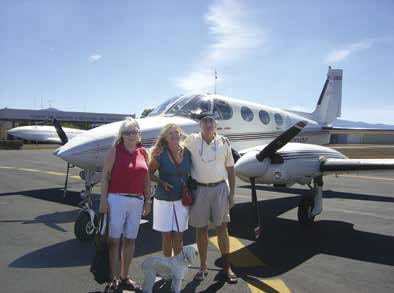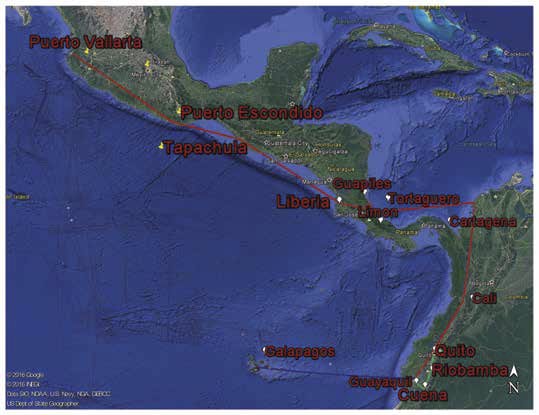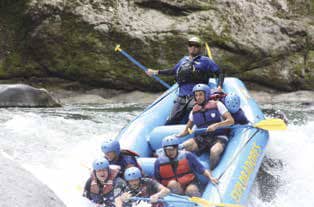Menu
Editor’s Note: Although Richard flew this trip six years ago, most of the information is still relevant. Readers should note, however, that 406 mHz ELTs are now required for trips south of the border.

In 2005 I owned a souped up Twin Comanche that had 200 HP engines. Having a winter home in Puerto Vallarta, Mexico, I became curious about visiting other nearby countries. Baja Bush Pilots offered a tour of Central America. I was in. All you had to do was show up; they made all the arrangements. It was a great trip that made us want to do more travel like this!
In 2011 I purchased N774DC, a 1977 Cessna 340A with excellent avionics. It was my second 340. The 340 has always been my ideal flying platform due to its pressurized cabin, air stair door, and docile handling characteristics.
My wife and I began talking about going to the Galapagos Islands in 2013. I suggested we hopscotch in the 340 from our home in Puerto Vallarta (MMPR) to Guayaquil, Ecuador, and then visit countries we had not visited on our previous Central American adventure. With only two weeks for the trip, we paired it down to Costa Rica, Colombia, and Ecuador. (We had already been to Guatemala, El Salvador, and Panama.) There were two parts to this adventure; planning it and flying it. Fortunately, as a member of Baja Bush Pilots, I was able to use their web site to get most of the necessary country contact information. As with most flying in Latin American countries there is a lot of bureaucracy to deal with. It takes patience and persistence.
The first thing to note in planning a trip like this is, unlike the USA, in all countries south (actually east) of Guatemala, you need permission to land BEFORE you get there. Some people use a “handler” at each airport. I could have avoided all the following if I had taken that route but I refused to pay someone $500 USD or more to shuffle a few papers that I already mostly knew how to do. At this point I should mention that you do not need know Spanish to either do the planning or deal with the airports when you arrive. Most forms have English translations and ALL aircraft communication with ATC and international airports is required to be done in English. A Handler can do all the paperwork shuffle when you arrive as well.
The permitting was challenging but because of the internet it turned out to be easier than I expected. Each country has its own FAA-type agency referred to as DGAC (Dirección General de Aeronáutica Civil), which is where you make application for an Entry Permit. As a regular flyer in Mexico I was very familiar with the documentation required by each country as it is very similar to Mexico’s. I made packets for each country that included aircraft registration, airworthiness certificate, pilot license, medical certificate, and copy of insurance showing coverage in Central/South America (which is standard on most policies). I had to get my insurance company to specifically add Colombia which was an additional cost.
Also required was a copy of my Entry Permit, a Corporate Permission to Import (if your airplane is owned by a corporation), which is a simple notarized document allowing you to temporarily bring the airplane into the country, and a General Declaration form that lists all passengers.
After a long day of flying in Mexico and overnighting in Tapachula (MMTP), the real adventure began in Costa Rica. Our research showed Costa Rica has great white water rafting and beautiful and interesting wildlife habitats on the Caribbean coast, so we elected to land at Liberia (MRLB) as our Airport of Entry. Liberia has a very modern, beautiful airport. This took us longer than expected as we did not have a General Declaration form (never again).
In every airport in all of the countries we visited we needed to deal with the following entities:
• Comandante’s Office (signs the flight plan that allows you to take off)
• Flight Planning (where you get your ICOA flight plan that they will help you fill out)
• Airport Office run by a private entity where you pay for parking and landing fees (most airports took credit cards or US dollars)
• Fuel office (all took credit cards)
It took us almost two hours to do all this (the airport was brand new and did not have all the signage installed), but I got a great education. Everybody was very helpful.
We refueled and took off VFR (CAVU weather) for our first Costa Rica overnight in Guapiles (MRGP). This airport was quite exciting. It was a small paved country airport that was close to our B&B. We were unable to contact the airport directly before we left but we went anyway. As we approached the airport we noticed very tall radio towers in the vicinity. We had to fly between them on final approach! The runway was very narrow – about as wide as our wing tips – but plenty long enough. We were able to get a mechanic working at the airport to call a taxi. The B&B was located on the edge of a beautiful river gorge. Very remote, but just what we needed.

The next day the white water raft company picked us up and we spent a wonderful day rafting. We were told that this is a quiet time for the river. I would hate to see what high water would be like.
The following day we departed for Totuguero (MRBT), on the Carribbean coast. This airport there was the exact opposite of Guapiles. The runway was very wide, made of concrete, and a piece of cake. When we taxied to the parking area it was clear that no one was there and the so-called FBO facility was abandoned.
The airport was on an island with nothing else around. Fortunately we arranged for our hotel to pick us up by boat before we took off. Totuguero was a very beautiful wildlife refuge with a few small hotels. We hired a guide who took us on a tour of the bayous, which were teaming with fascinating wildlife.
The following day, we took off for Limon (MRLM), our last stop in Costa Rica. We needed to refuel and it is also required to leave any of these countries from an Airport of Entry. We thought it would be a quick in and out at Limon, but that was not to be. Everything was going smoothly until we had to pay for my wife’s exit fee (no fee is required for the pilot). This had to be done at a bank in town. I continued to deal with the refueling and the flight planning as she went via taxi to the bank to pay the fee. Other than this additional time, everything went smoothly. N774DC continued to perform well with no mechanical or avionics issues.
Our next stop was Cartagena, Colombia (SKCG). The flight (VFR CAVU) was uneventful. We were able to get flight following from Limon direct to Cartagena. Clearly they are not used to that request, but ARTC in Costa Rica, Panama, and Colombia were accommodating.
Our arrival in Cartagena was visually breathtaking. You could easily see the contrast between to low-rise walled-in old city and the very high-rise new condo city!!
The landing and paper shuffle was easy and we were in a taxi within 45 minutes. Cartagena is a beautiful, fully restored colonial city. We did a lot of walking and eating. One thing I noted was that there were no large cathedrals like you see in most Latin American countries, just small churches.
One important thing to keep in mind while flying anywhere south of the border is that the refuelers DO NOT carry oil. Be sure to bring your own. I was running low on oil and asked the repair facility in Cartagena to get me a case which they were fortunately able to do by the following morning.

We spent three days in Cartagena. We went to the airport early in the morning expecting to leave quickly for our refueling stop in Cali, but they were having major thunderstorms and were closed temporarily. I suggested to Flight Planning that we stop at another airport for fuel. It was not that easy. When filing a landing request, Colombia requires specifics not required by any other country we visited. You are asked for the day and time of arrival AND any other airports you will be visiting in the country. I was also not aware that in order to visit other airports not on your Entry Permit, it takes 48 hours to get clearance. So we elected to wait for Cali to open. White water rafting in Costa Rica.
We were supposed to refuel in Cali (SKCL) and continue to Guayaquil, Ecuador, so we could make our commercial flight to the Galapagos. It was almost noon before we were able to depart. We made it to Cali with no problem, but it took a while to get refueled and daylight was waning. We went to Flight Planning who informed us that there was a lot of dicey weather enroute and the Comandante would not let us go until the next day.
The Cali airport is quite far from the city and we wanted to leave in the early AM. Well, there were no hotels near the airport. Very strange. A ground handler individual adopted us and told me that there was a hotel inside the airport. I had not seen any signs but he took us to what looked like an office area. There it was a “hotel.” They had one room left with air conditioning. We took it as we were dead tired by then. It turned out that this facility was only for air crews and had minimal amenities.
We were hungry and wanted to eat but there was no real restaurant in the airport. But there was a Subway, which was our main course, with Dunkin Donuts for dessert. We survived!
The next day was clear and we took off for Guayaquil (SETA), with one slight quirk en route. When we were handed off from Colombia ARTC to Ecuador ARTC they asked me for my landing permit number. Unfortunately that document was in the nose baggage. I faked it and made up a number. No further questions. Landing was uneventful and paper shuffle /customs was easy.
The B&B we booked was very nice, with a beautiful garden and a great breakfast. The next day we hired a guide to show us the city. It was not as grand as Cartagena, or the colonial cities in Mexico, but it was engaging, with an interesting wharf area and modern buildings. The following day we went back to the airport to catch our commercial flight to the Galapagos.
The Galapagos Islands are about 600 nm from Guayaquil, a little too far for my taste in the 340. More importantly, I learned that Guayaquil is the only airport in Ecuador that has 100LL, so there would have been no refueling in the Galapagos. Flying commercial was the right decision. I will skip the detail for the best part of the trip, as it could take up several pages, but the Galápagos Islands are fantastic, and visiting is a definite bucket list item. We booked a small boat that held about 50 people for a four-day excursion around the islands. The landscape and wildlife were fascinating and we met a lot of very interesting people. They all highly recommended that we visit Quito, Ecuador, and rent a car to drive the PanAm Highway south to Quenca, Ecuador.
I was dubious about not using my 340 for this but it turned out that driving was very much the right decision. It was breathtaking. Quito is at 9,350 feet and is a beautiful Spanish colonial city with lots of history and great restaurants. Our timing was interesting as they were in the middle of a presidential election on the Sunday after we arrived, and there was no liquor for sale until after the polls had closed. The main square had huge TV screens and lots of partying. What a treat.
For the next four days we drove hundreds of miles down the spine of the Andies with our altitude varying from 7,500 feet to over 14,000 feet. People were farming on what looked like 45 degree mountain slopes! The cows looked as though if they tripped they would roll all the way to the bottom. Describing all the fascinating cities and towns we visited on this leg of our trip would take a volume, so I’ll fast forward to Guayaquil airport.
After the paper shuffle, we started up the airplane and the STEC 65 would not turn on. Bummer. It was Sunday with no help except airline maintenance available. After about an hour, a guy came by to look at it but to no avail. We overnighted there. The next day I called STEC. They thought is was the power supply. Waiting another ten days for it to be fixed was not an option. We needed to get home.
I always wondered if I would be up to flying a long trip without an autopilot, and for the first time in my 50-year flying career I was about to find out. We took off IFR for Cali to refuel. It was IFR all the way to Cali and I had to shoot an approach. It was not quite as bad as I’d anticipated, but there was lots of intense concentration. Cali was a quick fuel stop turnaround- we had gotten good at it by then. We departed IFR for Limon, Costa Rica. After about 20 minutes we were VFR and CAVU.
Another quick turn at Limon, and our next stop was to overnight in Tapachula, Mexico. All went well until we approached Tapachula, where the humidity must have been 200%. Even though it was technically VFR, the bright, thick haze made it necessary to fly on instruments. The landing
was uneventful. We were tired and ready for a hotel but our Holiday Inn Express had lost our reservation and was fully booked. Fortunately our taxi driver found us a clean hotel that had a restaurant. We were happy again.
The next day we made it back to Puerto Vallarta. No autopilot and 14 hours of hand flying. I guess I got the answer to my question: yes, I could do it. This was just one more experience to add to one of the most amazing adventures I’ve ever had.
I encourage any of our members who’ve ever considered making such a trip to go ahead and do it! There is no better use of your Twin Cessna!